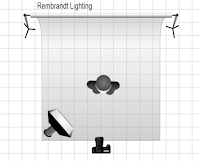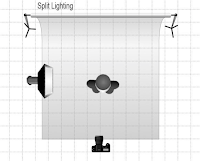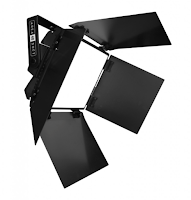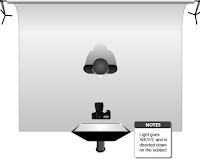Studio Lights.
Rembrandt.
The Rembrandt lighting has been inspired by a Dutch painter born in 1606. His style of painting often left a triangle of lighting under the subjects eye. This type of lighting has been adapted as Hollywood grew as it was often used on Hollywood actors and actresses as it is a good technique due to the fact it is "simple, effective lighting setup that is flattering to a wide variety of subjects and is easy to master quickly" . When creating this on my own I used the lighting set up demonstrated below and has a slight triangle under the subjects eye however it didn't turn out as prominent as originally expected so if I was to do this again I would make sure that the light was a more of a 45 degree angle and possibly use a reflector in order to get the light correctly under the subjects eye.

Butterfly Lighting.
Butterfly lighting is a lighting technique where it adds shadows underneath the subjects face most notably the shadow under the nose which often resembles a butterfly. This shadow is created by using a key light directly in front the subjects face and slightly above pointing down in order to create the shadow effect. Similarly to Rembrandt lighting this style was also often used on Hollywood actors and Actresses in particularly in the Paramount Movie Studios of old Hollywood. I feel that my first try in creating this style of lighting is effective as it clearly defines the shadows under the subjects facial features with emphasis under the subjects nose. However if I was to recreate this shot I would try and make sure that the lighting wasn't as low key as it was and try to make it more high key.
Edge Lighting.
Split lighting is created by using one light source which is placed 90 degrees to the subjects face in order to illuminate one side of the face and cast a shadow on the other side often in complete darkness. This style of lighting is 'used a lot in film noir cinematography' as it can be used to suggest the characters battle of moral ambiguity and show the binary opposition of good vs evil within the character as they may be doing bad things for a good reason. I feel that my demonstration of edge lighting is effective as it add dramatic effect while showing a clear divide between light and shadow on the subjects face, however if I was to recreate this I would attempt to find edge lighting in a natural set up to experiment with all the ways this style of lighting can be created.

Low key lighting.
Low key lighting is often a big part of the technical conventions in genres like Horror or Film Noir this is because it often gives connotations of mystery or fear or the unknown. Low key lighting occurs when there is only 1 light source and casts shadows withing the mise-en-scene. When experimenting with low key lighting I found a dark corridor and used a torch propped up on a chair in order to cast a shadow. I got the subject to just walk past the camera and in the low key lighting they almost looked like a silhouette with a shadow casted on the wall as they walked past. I feel that this experiment with the low key lighting is effective as you can see the detail in the shot but the light is dark enough to not have everything in the scene be illuminated. However when looking at the health and saftey of low key lighting I would have to make sure that there is nothing blocking the subjects path that would cause the to trip and make sure that they can see well enough to know where they are walking
High key Lighting.
High key lighting is used to illuminate the scene evenly and reduces the amount of shadows produced in order to give the connotations of feeling positive and gives the opposite effect of low key lighting. High key lighting means that multiple subjects in the frame are all evenly lighted insreda of falling victium to shaodows. When experimenting with high key lighting I chose to shot outside when it was fairly sunny so that the shot wouldbe fully illuminated. One problem with this is that I didnt use any other light source and primarily relied on ambient lighting to light up the shot meaning that some shadows could be caused. However when looking at my shot minimal shadows are used and the small ones created work effectively at giving the shot a greater sense of verisimilitude.
Experimental lighting 1.

When first experimenting with lighting I used a portable area 48 Led light to help create the dramatic effect of the shadow behind the subject in a low key light while also illuminating the subjects face. I placed the light to the right of the subjects face around 45 degrees in order to get the effect that was created. I feel like my first experiment with light was effective as it illuminated the features of the subjects face without over lighting the background to keep it dark and dramatic. When looking at health and safety I had to make sure that the light didn't get overheated so that is didn't trip out and stop working, I also had to make sure that the subject didn't get overheated
Experimental lighting 2.
When creating my second experimental lighting I used the same area 48 LED light by increasing the intensity of the light to add more of a high key lighting effect, while doing this I placed a hand near the bottom of the light to cast a slight shadow on the bottom half of the subjects face in order to help highlight the subjects eyes. In terms of health and safety I made sure the the light wasn't too hot for someone to hold their hand in front in order to make sure that they don't get burned, and make sure that the light doesn't overheat and trip out. I would also make sure that the subject is comfortable and isn't overheated.
- 1) Blian Brown (2012), Lighting basics, Cinematography Theory and Practice Image Making for Cinematographers and Directors, Second edition, The Boulevard, Langford Lane, Kidlington, Oxford OX5 1BG UK, 2012, 106
- 2) The Beat (9th Januray 2018) (online) avaliable from https://www.premiumbeat.com (accessed 30th september 2018) https://www.premiumbeat.com/blog/high-key-vs-low-key-lighting/

No comments:
Post a Comment